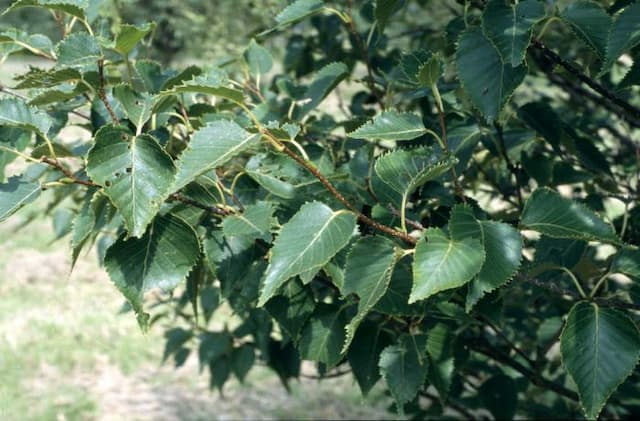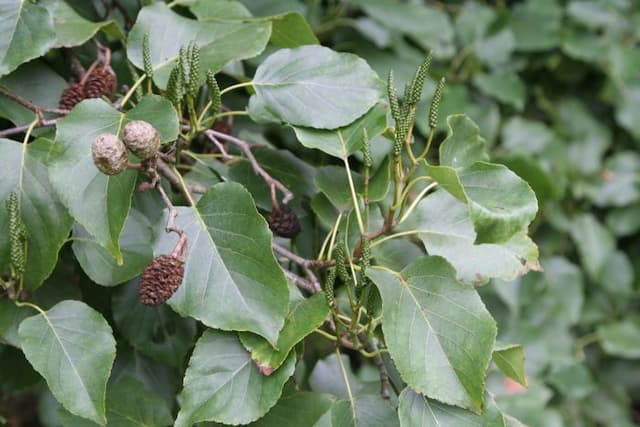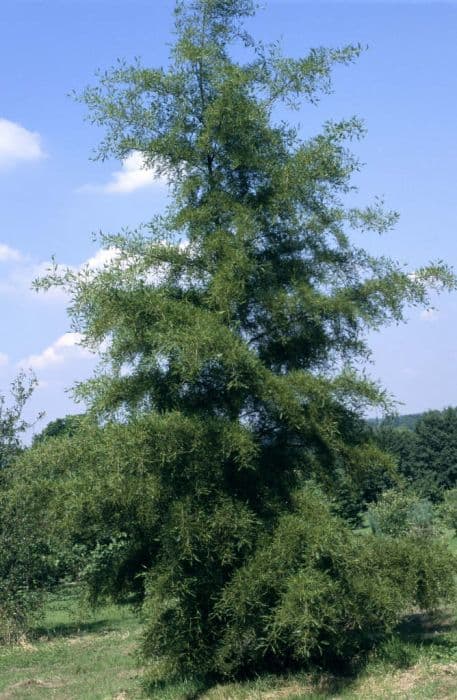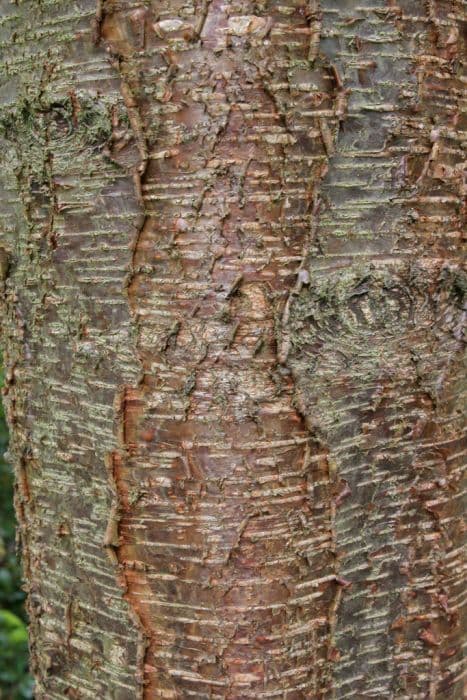Oriental Hornbeam Carpinus orientalis

ABOUT
Commonly known as Oriental hornbeam, this plant is recognized by its distinctive foliage and bark. The leaves are small, oval to slightly elongated with a finely toothed margin, resembling a serrated edge. They display a rich green color that transitions to a yellow or yellowish-brown in the autumn, offering a seasonal visual interest. The bark is smooth and gray, providing a notable contrast to the foliage. As the Oriental hornbeam matures, the bark can develop subtle vertical furrows that add texture to the tree's appearance. Its branching structure is typically dense, with a well-proportioned and rounded canopy that supports the foliage. Delicate catkins, which are long, slim flower clusters, appear in spring and add a subtle decorative aspect to the plant. Following the flowering period, small, inconspicuous fruit can be observed, which is of interest to various bird species. The overall impression of the Oriental hornbeam is one of elegance and hardiness, making it a favored choice in landscaping for its ornamental qualities.
About this plant
 Names
NamesFamily
Betulaceae
Synonyms
Oriental Hornbeam, Eastern European Hornbeam
Common names
Carpinus betulus var. orientalis, Carpinus betuloides, Carpinus caucasica, Carpinus orientalis var. macrocarpa, Carpinus orientalis var. microcarpa, Carpinus orientalis f. microcarpa, Carpinus pumila.
 Toxicity
ToxicityTo humans
Oriental hornbeam, or Carpinus orientalis, is generally not recognized for being toxic to humans. There are no well-documented cases of poisoning from ingestion of this plant. However, it is always advisable to exercise caution and avoid ingesting parts of ornamental plants due to the potential for individual allergic reactions or unknown toxins.
To pets
The Oriental hornbeam is not known to be toxic to pets. No significant toxic effects have been widely reported in animals such as dogs, cats, or horses upon ingesting leaves or any parts of this plant. However, similarly to humans, the potential for individual sensitivity or allergic reactions exists, and it is generally wise to prevent pets from consuming non-food plants.
 Characteristics
CharacteristicsLife cycle
Perennials
Foliage type
Deciduous
Color of leaves
Green
Flower color
Varies
Height
20-25 feet (6-7.5 meters)
Spread
15-20 feet (4.5-6 meters)
Plant type
Tree
Hardiness zones
5
Native area
Southeastern Europe
Benefits
 General Benefits
General Benefits- Shade Provider: Carpinus orientalis, commonly known as Oriental hornbeam, offers shade and reduces heat in gardens and parks due to its canopy.
- Erosion Control: The root system helps to stabilize soil and prevent erosion on slopes and riverbanks.
- Habitat for Wildlife: It supports biodiversity by providing habitat and food for a variety of wildlife, including birds and insects.
- Aesthetic Appeal: With its attractive foliage and structure, the Oriental hornbeam is used for ornamental purposes in landscapes.
- Durable Wood: The wood is hard and resistant, useful for carpentry, tool handles, and furniture.
- Urban Tolerant: It is tolerant of urban pollution and soil compaction, making it suitable for city environments.
- Windbreak: The dense foliage and strong branches can act as a protective barrier against strong winds.
 Medical Properties
Medical Properties- Antioxidant activity: Folk medicine has used Carpinus orientalis for its antioxidant properties which may help to neutralize harmful free radicals in the body.
- Anti-inflammatory effects: The plant has been traditionally used to reduce inflammation, potentially benefitting conditions characterized by swelling and pain.
- Antimicrobial potential: Extracts of Carpinus orientalis may possess antimicrobial properties, which could be useful in preventing or treating infections.
 Air-purifying Qualities
Air-purifying QualitiesThis plant is not specifically known for air purifying qualities.
 Other Uses
Other Uses- Carpinus orientalis, also known as Oriental Hornbeam, wood can be used in the making of musical instruments, such as woodwind instruments, due to its hard and dense nature providing good acoustics.
- The wood is also suitable for fine carving and detailed woodworking projects like inlays and marquetry for its fine grain and workability.
- Oriental Hornbeam's charcoal is highly prized for artistic drawing, as it provides consistent lines with a range of tones.
- The tree's dense and heavy wood makes it ideal for tool handles, offering durability and shock resistance.
- Due to its heat tolerance and slow-burning characteristics, Oriental Hornbeam charcoal is used in traditional grilling and barbecuing in some cultures.
- Carpinus orientalis is also used in landscaping as a hedge or screen plant due to its dense foliage and ability to withstand heavy pruning.
- The wood of Oriental Hornbeam serves as an excellent material for the construction of parquet flooring, often appreciated for its durability and fine texture.
- The plant can be used for bonsai cultivation because of its small leaves and flexibility in shaping.
- Bentwood furniture, which requires steaming and bending wood into curved shapes, can be made from Oriental Hornbeam owing to the wood's pliability when steamed.
- Oriental Hornbeam can be used in turnery, the art of shaping wood using a lathe, thanks to its even texture and minimal grain distortion.
Interesting Facts
 Feng Shui
Feng ShuiThe Oriental hornbeam is not used in Feng Shui practice.
 Zodiac Sign Compitability
Zodiac Sign CompitabilityThe Oriental hornbeam is not used in astrology practice.
 Plant Symbolism
Plant Symbolism- Resilience: Carpinus orientalis, commonly known as Oriental hornbeam, exhibits strong wood and an ability to withstand tough conditions, symbolizing resilience and the ability to endure hardships.
- Flexibility: The wood of the Oriental hornbeam is known for being both strong and flexible, which can symbolize adaptability and the capability to bend without breaking when faced with challenges.
- Stability: With its deep roots and sturdy trunk, the Oriental hornbeam represents stability and steadfastness, signifying the importance of a solid foundation in life.
- Protection: The dense canopy formed by its leaves offers shade and protection, symbolizing the role of shelter and guardianship in one’s life.
- Longevity: As a species that can live for a considerable amount of time, the Oriental hornbeam embodies the concept of long life and perseverance.
 Water
WaterThe Oriental hornbeam prefers a consistent moisture level, so it's essential to water it regularly. In general, water the plant once a week, providing about 1-2 gallons depending on the size of the tree and the soil moisture levels. During hot or dry spells, check the soil more frequently, as you may need to water twice a week. It's best to water deeply and slowly, directing the water to the root zone. Ensure that the soil is well-draining to prevent waterlogging, which can be harmful to the plant.
 Light
LightThe Oriental hornbeam thrives in full sun to partial shade. The ideal location would offer morning sunlight with some shade during the hottest part of the day, especially in areas with intense afternoon sun. Adequate light is crucial for healthy growth and foliage development but avoid placing it in locations where the midday sun is too harsh.
 Temperature
TemperatureThe Oriental hornbeam is hardy and can tolerate a range of temperatures. It can survive minimum temperatures down to -20°F and is comfortable in zones 5 through 9. The ideal temperature range for optimal growth is between 60°F and 80°F. Extreme temperature fluctuations should be avoided, as they can stress the tree.
 Pruning
PruningPruning an Oriental hornbeam is essential to maintain its shape and health. Prune in late winter or early spring before new growth begins. Remove any dead, diseased, or crossing branches to improve air circulation and light penetration. Thinning out dense areas will also promote a healthy structure. The frequency of pruning will depend on the desired shape and size of the tree, but typically, light annual pruning is sufficient.
 Cleaning
CleaningAs needed
 Soil
SoilOriental Hornbeam thrives in well-drained, fertile soil with a pH ranging from slightly acidic to neutral (pH 5.5 to 7.5). A mix of loam, sand, and compost is ideal to ensure good drainage and fertility.
 Repotting
RepottingOriental Hornbeams are generally slow-growing trees and do not require frequent repotting. Repotting can be done every three to five years to refresh the soil and to allow for growth.
 Humidity & Misting
Humidity & MistingOriental Hornbeam requires moderate to high humidity levels. Maintaining the humidity around 40-65% is beneficial for the tree’s health.
 Suitable locations
Suitable locationsIndoor
Provide bright light, moderate water, and good air flow for Oriental Hornbeam.
Outdoor
Plant in well-drained soil, partial to full sun, protect from strong winds.
Hardiness zone
5-9 USDA
 Life cycle
Life cycleThe Oriental Hornbeam (Carpinus orientalis) begins its life cycle with seed germination, where the seed requires damp, well-drained soil and can benefit from a period of stratification to break dormancy. After germination, a seedling emerges and gradually develops into a juvenile plant, where it establishes roots and begins to grow leaves and a woody stem. As it matures into an adult plant, the Oriental Hornbeam develops a dense, rounded canopy with ovate to lance-shaped leaves, and the tree starts to flower, producing catkins that are wind-pollinated. Following pollination, the tree produces small nutlets that are encased in leafy bracts, which will serve as the seeds for the next generation once they disperse, often with the help of wind or animals. The Oriental Hornbeam can live for many years, continuing the cycle by flowering and producing seeds annually. Eventually, the tree reaches its senescent phase, where growth slows, and it becomes more susceptible to environmental stresses, disease, and decay, until it dies, completing its life cycle.
 Propogation
PropogationPropogation time
Spring to Summer
Propogation: For the Oriental Hornbeam, which is the common name for Carpinus orientalis, the most popular method of propagation is by seed. The best time to collect seeds is in the fall when they ripen. Once collected, the seeds require stratification, which is a process of exposing them to cold temperatures to break their dormancy. This can be done by mixing the seeds with a slightly moist medium like sand or peat moss and storing them in the refrigerator at about 34-41°F (1-5°C) for approximately 60-90 days. After stratification, seeds should be sown in pots or a nursery bed in the spring, covered lightly with soil, and kept moist until germination occurs. Germination can be slow and irregular, so patience is essential when propagating the Oriental Hornbeam by seed.









